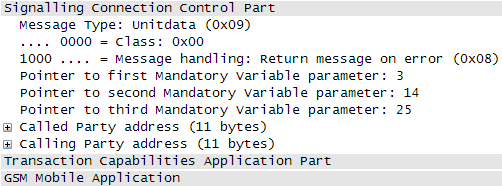SCCP class
SCCP provides 5 classes of protocol to its applications:
- Class 0: Basic connectionless.
- Class 1: Sequenced connectionless.
- Class 2: Basic connection-oriented.
- Class 3: Flow control connection oriented.
- Class 4: Error recovery and flow control connection oriented.
The connectionless protocol classes provide the capabilities needed to transfer one Network Service Data Unit (NSDU) in the "data" field of an XUDT, LUDT or UDT message. When one connectionless message is not sufficient to convey the user data contained in one NSDU, a segmenting/reassembly function for protocol classes 0 and 1 is provided. In this case, the SCCP at the originating node or in a relay node provides segmentation of the information into multiple segments prior to transfer in the "data" field of XUDT (or as a network option LUDT) messages. At the destination node, the NSDU is reassembled.
The connection-oriented protocol classes (protocol classes 2 and 3) provide the means to set up signalling connections in order to exchange a number of related NSDUs. The connection-oriented protocol classes also provide a segmenting and reassembling capability. If an NSDU is longer than 255 octets, it is split into multiple segments at the originating node, prior to transfer in the "data" field of DT messages. Each segment is less than or equal to 255 octets. At the destination node, the NSDU is reassembled.
Contents |
Class 0: Basic connectionless
The SCCP Class 0 protocol class is the most basic of the SCCP protocol classes. Network Service Data Units passed by higher layers to the SCCP in the originating node are delivered by the SCCP to higher layers in the destination node. They are transferred independently of each other. Therefore, they may be delivered to the SCCP user out-of-sequence. Thus, this protocol class corresponds to a pure connectionless network service. As a connectionless protocol, no network connection is established between the sender and the receiver.
Class 1: Sequenced connectionless
SCCP Class 1 builds on the capabilities of Class 0, with the addition of a sequence control parameter in the NSDU which allows the SCCP User to instruct the SCCP that a given stream of messages should be delivered in sequence. Therefore, Protocol Class 1 corresponds to an enhanced connectionless protocol with assurances of in-sequence delivery.
Class 2: Basic connection-oriented
SCCP Class 2 provides the facilities of Class 1, but also allows for an entity to establish a two-way dialog with another entity using SCCP.
Class 3: Flow control connection oriented
Class 3 service builds upon Class 2, but also allows for expedited (urgent) messages to be sent and received, and for errors in sequencing (segment re-assembly) to be detected and for SCCP to restart a connection should this occur.
Examples
Class 0 SCCP message
Class 1 SCCP message
Reference
http://en.wikipedia.org/wiki/Signalling_Connection_Control_Part
ITU-T Recommendation Q.714 - Signalling connection control part procedures

